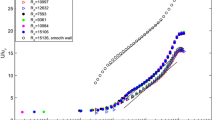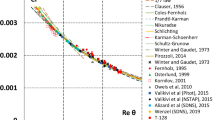Abstract
A 2-D turbulent boundary layer experiment with zero pressure gradient (ZPG) has been carried out over a rough and a smooth surface using two cross hot-wire probes. Wind tunnel speeds of 10 m/s and 20 m/s were set up in order to investigate the effects of the upstream conditions and the Reynolds number on the downstream flow. For a given set of upstream conditions, such as the wind tunnel speed, trip wire size and location, the three components of the velocity field were measured from about 14 m from the inlet of the wind tunnel to 30 m downstream. This experiment is unique because it achieves Reynolds numbers as high as R θ ≅120,000, for which measurements of the mean velocity are reported. It is shown that by fixing the upstream conditions, the mean deficit profiles collapse with the freestream velocity, \(U_{\infty } \), but to different curves depending on the upstream conditions and surface roughness. Moreover, the effects of the upstream conditions, the Reynolds number, and roughness are completely removed from the outer flow when the mean deficit profiles are normalized by the Zagarola/Smits scaling, \(U_{\infty } \frac{{\delta _{ * } }}{\delta }\). Consequently, the true asymptotic profile in the turbulent boundary layer is found in ZPG flow regardless of the range of Reynolds number, surface conditions and initial conditions.


















Similar content being viewed by others
References
Bradshaw P (1966) The turbulence structure of equilibrium boundary layers. NPL Aero Report 1184
Castillo L (2000) Application of Zagarola/Smits scaling in turbulent boundary layers with pressure gradient. In: Rohnman M, Brebbia CA (eds) Advances in fluid mechanics III. WIT, Boston, MA, pp 275–288
Castillo L, Johansson G (2002) The effect of the upstream conditions on a low Reynolds Number turbulent boundary layer with zero pressure gradient. J Turbul 3:31
Castillo L, Walker D (2002) Effect of upstream conditions on the outer flow of turbulent boundary layers. AIAA J 40(7):1292–1299
Castillo L, Walker D, Wosnik M (2000) The effect of the upstream conditions on the mean velocity deficit of turbulent boundary layers. At: AIAA Fluids 2000 Conference and Exhibition, 22 June 2000, Denver, Colorado, Paper AIAA 2000–2309, Colorado
Clauser FH (1954a) The turbulent boundary layer. Adv Appl Mech 4:1–51
Clauser FH (1954b) Turbulent boundary layers in adverse pressure gradients. J Aeronaut Sci 21:91–108
Erm LP, Joubert PN (1991) Low Reynolds Number turbulent boundary layers. J Fluid Mech 230:1–44
Fernholz HH, Finley PJ (1996) The incompressible zero pressure gradient turbulent boundary layer: an assessment of the data. Prog Aerosp Sci 32:245–311
Gad-del-Hak M (2000) Flow control: passive, active and reactive flow management. Cambridge University Press, Cambridge, UK
George WK, Castillo L (1997) Zero-pressure gradient turbulent boundary layer. Appl Mech Rev 50:689–729
Hama FR (1954) Boundary layer mechanics for smooth and rough surfaces. T Soc Naval Arch Marine Eng 62:333–358
Hites M, Nagib H (1995) High Reynolds number boundary-layer measurements in the NDF. AIAA 95-0786
Johansson TG, Castillo L (2001) LDA measurements in turbulent boundary layers with zero pressure gradient. In: Lindborg E, Johansson A, Eaton J, Humphrey J, Kasagi N, Leschziner M, Sommerfeld M (eds) Proc 2nd Int Symp Turbulence Shear Flow Phenomena, 27–29 June 2001, Stockholm, Sweden
Klebanoff PS, Diehl ZW (1952) Some features of artificially thickened fully developed turbulent boundary layers with zero pressure gradient. NACA (National Advisory Committee for Aeronautics) Report 1110
Mi J, Nobes DS, Nathan GJ (2001) Influence of jet exit conditions on the passive scalar field of an axisymmetric free jet. J Fluid Mech 432:91–125
Österlund J (1999) Experimental studies of zero pressure-gradient turbulent boundary-layer flow. PhD Thesis, KTH (Royal Institute of Technology), Stockholm, Sweden
Perry AE, Schofield WH, Joubert PN (1969) Rough wall turbulent boundary layers. J Fluid Mech 37:383–413
Raupach MR, Antonia RA, Rajagopalan S (1991) Rough-wall turbulent boundary layers. Appl Mech Rev 44:1–25
Rotta J (1951) Beitrag zur berechnung der turbulenten grenzschichten. Ing Arch 19(1):31–41
Schlichting H (1968) Boundary layer theory, 6th edn. McGraw-Hill, New York
Slessor MD, Bond CL, Dimotakis PE (1998) Turbulent shear-layer mixing at high Reynolds numbers: effect of inflow conditions. J Fluid Mech 376:115–138
Smith DW, Walker JH (1959) Skin-friction measurements in incompressible flow. NACA (National Advisory Committee for Aeronautics) Report R26
Smith R (1994) Effect of Reynolds number on the structure of turbulent boundary layers. PhD Thesis, Princeton University, Princeton, NJ
Tennekes H, Lumley JL (1972) A first course in turbulence. MIT, Cambridge, MA
Wieghardt K (1943) Über die wandschubspannung in turbulenten reibungsschichten bei veränderlichem aussendruck. No UM-6603, Kaiser Wilhelm Institut für Strömungsforschung, Göttingen
Wosnik M (2000) On wall-bounded turbulent shear flows. PhD Thesis, University of Buffalo, Buffalo, NY
Zagarola MV, Smits AJ (1998a) Mean-flow scaling of turbulent pipe flow. J Fluid Mech 373:33–79
Zagarola MV, Smits AJ (1998b) A new mean velocity scaling for turbulent boundary layers. Proc FEDSM-98, 1998 ASME Fluids Engineering Division Summer Meeting, 21–25 June 1998, Washington DC, Paper No 4950
Author information
Authors and Affiliations
Corresponding author
Rights and permissions
About this article
Cite this article
Castillo, L., Seo, J., Hangan, H. et al. Smooth and rough turbulent boundary layers at high Reynolds number. Exp Fluids 36, 759–774 (2004). https://doi.org/10.1007/s00348-003-0758-y
Received:
Accepted:
Published:
Issue Date:
DOI: https://doi.org/10.1007/s00348-003-0758-y




